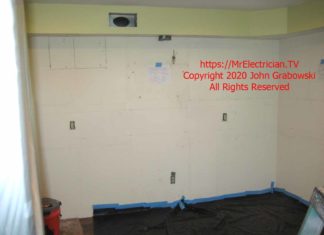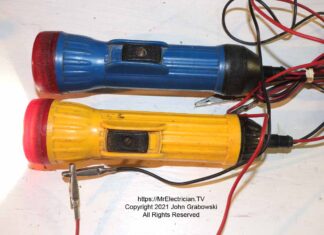Tag: ReceptXtenders
Extend Kitchen Electrical Outlets
Dear Mr. Electrician: How do I extend the kitchen electrical outlets from the wall a little so I can add ceramic tile?
Answer: Using electrical box outlet extenders or receptacle extenders is a simple and approved method for extending kitchen electrical outlets when the wall depth changes.
NOTE: Some text links below go to applicable products on eBay and Amazon. As an Amazon Associate, I earn from qualifying purchases. Using my links helps to keep this website FREE.
To use outlet box extenders, the existing electrical outlet box must be in good condition, and the screw holes must be able to hold 6/32 machine screws tightly. Otherwise, the existing electrical box should be replaced.
Electrical receptacles or box extenders are required when adding depth to a wall as per article 314.20 in the National Electrical Code (NFPA 70). Electrical boxes must be flush with the finished surface to prevent sparks from getting onto combustible wall materials and support the wiring device.
Below are photos from a kitchen remodel I worked on. Some of the existing electrical boxes remained in place, while others had to be relocated. Adjustable-depth electrical boxes and ReceptXtenders were both used on this job.
HOW TO EXTEND KITCHEN ELECTRICAL OUTLETS
Often, I find that the original plastic electrical box needs replacing, in which case I use adjustable depth boxes to adjust the box to the perfect depth when the wall is finished.
Below is the process I went through to accommodate the new kitchen cabinet arrangement and tile backsplash with new and existing electrical outlets.
Most of the existing outlets did not need to be relocated; the electrical boxes just needed extending. A new wall oven was going to be installed, so I moved the outlet from that location.
I had to change the ceiling light switch that someone had moved in a previous renovation. There was already a switch and light above the sink so I could use some of the existing wiring for the new low-voltage sink lights.
I first drew a couple of level lines at the backsplash height and cut out the drywall where I needed to work. The job called for installing new undercabinet lighting and extending and relocating outlets. You can see part of the undercabinet lighting installation in my post here.
I like to use adjustable-depth electrical boxes for kitchen and bathroom outlets and switches. That way, I am prepared for any thickness of the finished wall or backsplash.
After I install the adjustable depth boxes during the rough-in wiring phase of construction, I adjust them to stick out further than needed. That ensures that whoever installs the wall coverings will entirely cut around the electrical box.
If I kept the box recessed, I would have to cut the hole bigger to accommodate the wiring device because the wall finishers have a tendency to overlap the electrical box. I have no problem cutting drywall, but tile and stone are more challenging.
CLICK HERE to See Adjustable Electrical Boxes on Amazon
As depicted above, I prefer to leave the boxes protruding from the wall a little so...
Tool Reviews
Dear Mr. Electrician: What tool reviews have you written for products you have used?
Answer: Tool reviews of my tools are down below.
NOTE: Some text links below go to applicable products on Amazon. As an Amazon Associate, I earn from qualifying purchases. Using my links helps to keep this website FREE.
There are several tools I have grown to love working with because work goes so much better with the proper tools. Having the right tool for the job increases productivity and helps ensure the work is done correctly. My tool reviews are based on my actual use of the tools as part of my work as an electrician.
I can confidently say that not everything is manufactured to the same standards, and identical services from different companies don't always match up. Now more than ever, shopping around to find the best deal or product for you and your needs is essential. Read many tool reviews.
One of my favorite tools from my young electrician days that I still use occasionally is my Bright Star 1618-CT continuity testing flashlight(s). See the photo at the top of this post. They are convenient for checking fuses and incandescent or halogen light bulbs. They are also suitable for identifying wires on dead circuits or wires that are shorted together.
The flashlight has a jack in the back screw cap that a set of alligator leads can plug into. After the leads are inserted, the flashlight will only light when the two alligator clips are connected.
I saw LED upgrade kits for these flashlights in a store, so I bought one. The original PR-type incandescent bulb was not that bright.
The original manufacturer no longer makes these flashlight continuity testers, but plenty of other types of testers are available.
I have always been a tool nut, and when I was much younger, I would buy tools because I liked them and hoped to be able to use them one day. I have many tools in my collection that I have never or hardly ever used.
My current advice is to wait until I need the tool unless a bargain buying opportunity comes along that is too good to pass. My tool reviews are based on my experiences using them while working as an electrician.
Top Of Page
TOOL REVIEWS
My three Ideal voltage testers have been with me for a long time. The model on the right also has a built-in continuity tester.
I have several small pry bars that come in handy during remodeling jobs.
Another handy tool to have is a thread-restoring file. Suitable for when you have to cut some screws or bolts.
I love my Klein Lineman Pliers with the built-in crimper.
If you want to give a gift to an electrician, this would be a good one. A Burndy Wire-Mike is suitable for determining wire and conduit sizes.
I initially bought the protractor level with a magnetic base to bend the conduit.
Top Of Page
I have used BX cutters since I was a kid. Working with my dad in the 1960s, we mostly installed BX cables. A...

